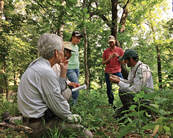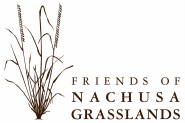Potential Research Topics at Nachusa Grasslands

The following is an evolving compilation of research questions pondered by stewards and staff at Nachusa Grasslands. Friends of Nachusa Grasslands would like to support scientific research that provides insight into the answers to these questions but will not restrict its science grant awards to research endeavors that address only these specific questions.
This list is meant to encourage researchers who are thinking of doing work at Nachusa to consider these and related research topics in their planning.
This list is meant to encourage researchers who are thinking of doing work at Nachusa to consider these and related research topics in their planning.
Impacts and management of exotic invasive species (both plant and non-plant) For example:
- How do non-native invasive species (plant, insect, etc.) compete with native species? Both within and between trophic groups?
- Specific questions about Lotus corniculatus (bird’s foot trefoil): How do available herbicides (e.g. Garlon 3A, Transline, Crossbow, a basal bark mix) compare in actually killing the plant? What percentage of an individual plant needs to be treated to kill a plant? Do the roots of treated plants stay alive to overwinter and sprout again in the spring even if the plant is top-killed? What is the killing radius of specific herbicides, i.e. impact on nearby non-target species? How much of the root structure needs to be removed to make digging up plants an effective strategy?
- How can Trifolium pretense (red clover), Phalaris arndinacea (reed canary grass), and Melilotus sp. (sweet clover) and other non-native invasive plants be eradicated or greatly reduced most effectively? Original and creative hypotheses are welcome.
- Does overseeding lead to increased plant diversity and effectively push out unwanted species (invasive, non-native, and/or weedy natives)? Can species mixes be designed for highly resistant communities? Can fire and/or grazing regimes be modified to reduce non-native competition?
- In a changing climate, which invasive species are expected to become more competitive with natives? Are there non-native invasive plants that could move into the region or that may already be here that could become invasive? Which species should we be on guard for? How can the introduction of these species to the preserve be prevented?
- What non-native animal species exist on the preserve? What impact do they have on native species populations? Can and should they be eradicated?
Resistance and resilience of restored tallgrass prairie community to disturbance management (e.g. fire and/or grazing)
For example:
For example:
- How does fire frequency and grazing affect specific insect populations? Do unburned sites leave sufficient refuge for these insect species? There is some on-going research investigating these questions around regal fritillary butterflies and some moth species. We welcome work for other species. Are the eggs and/or larva surviving fires, or are larva only surviving in unburned units? How can we better manage, restore, and reconstruct prairie to promote diverse and abundant insect populations?
- What effect is repeated fire and/or grazing having on the shrub and tree layers of Nachusa’s savannas and woodlands?
- How does fire and grazing impact multiple plant and animal populations? Can we make better or more nuanced management decisions if we understand how plants and animals are interacting in response to disturbance? How do we approach management for whole ecosystem diversity and resilience?
Restoring habitat for rare and declining prairie, savanna, and aquatic species (including plants, animals, fungi, etc). For example:
- We have inventories of a few groups of insects at Nachusa (odonates, bees, moths, butterflies, specialized orthopterans, mosquitoes, ground and dung beetles, ticks), but we need to know more about all of the insect populations present. What species are present, and how does management affect their populations?
- We know some populations of native bees are using restorations. Are other remnant-dependent or endangered insect species using the restorations? How can we encourage persistence of these species in restorations?
- Inventory studies on flora and fauna have led to several long-tern research projects with tangible management outcomes. We welcome further studies to “find out what we have” at Nachusa to provide additional management insight.
- We need better and more consistently acquired data on the health of our aquatic habitats (both streams and wetlands). What physical, chemical, and biological changes occur over time, and can these changes be correlated with restoration efforts?
- Improving germination of Comandra umbellata is a goal of unit stewards. A recent study at Nachusa examined correlations between genetic diversity, stand characteristics, mycorrhizal communities, and soil characteristics. It found that genetic diversity across the preserve was isolated, and diversity within stands varied by phosphorus availability. Possible questions for research include: How does phosphorus availability impact flower and seed production? Could facilitated pollen transfer between identified genetic groups of C. umbellata produce greater numbers of seed and/or more consistently viable seed? Does seed recruitment depend on soil characteristics and/or density of C. umbellata stems?
- What’s the best way to turn an old pasture full of brome grass and weeds into a biologically diverse native prairie? We have several pastures we are thinking about seeding. What’s the best way to proceed? Round them up first? Use grass herbicide first? Seed directly into the brome? Other ideas?
- Sandhill cranes have nested at Nachusa. What management strategies would attract and maintain a breeding population of bobolinks or prairie chickens? Or other less common faunal species? What needs to be done to increase the presence and abundance of these species?
- Flies can transmit disease in bison. What fly species do we have and are they vectors for these common diseases? How could we manage to break disease cycles with minimal impact on other native species?
UPDATED 09/2023
